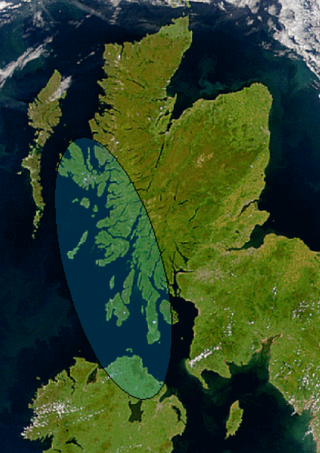Kenneth MacAlpin or Kenneth I was King of Dál Riada (841–850), and King of the Picts (848–858), of likely Gaelic origin. According to the traditional account, he inherited the throne of Dál Riada from his father Alpín mac Echdach, founder of the Alpínid dynasty. Kenneth I conquered the kingdom of the Picts in 843–850 and began a campaign to seize all of Scotland and assimilate the Picts, for which he was posthumously nicknamed An Ferbasach. He fought the Britons of the Kingdom of Strathclyde and the invading Vikings from Scandinavia. Forteviot became the capital of his kingdom and Kenneth relocated relics, including the Stone of Scone from an abandoned abbey on Iona, to his new domain.

The 9th century was a period from 801 through 900 (CM) in accordance with the Julian calendar.
The 830s decade ran from January 1, 830, to December 31, 839.
The 840s decade ran from January 1, 840, to December 31, 849.
The 850s decade ran from January 1, 850, to December 31, 859.
The 780s decade ran from January 1, 780, to December 31, 789.

Year 778 (DCCLXXVIII) was a common year starting on Thursday of the Julian calendar, the 778th year of the Common Era (CE) and Anno Domini (AD) designations, the 778th year of the 1st millennium, the 78th year of the 8th century, and the 9th year of the 770s decade. The denomination 778 for this year has been used since the early medieval period, when the Anno Domini calendar era became the prevalent method in Europe for naming years.

Dál Riata or Dál Riada was a Gaelic kingdom that encompassed the western seaboard of Scotland and north-eastern Ireland, on each side of the North Channel. At its height in the 6th and 7th centuries, it covered what is now Argyll in Scotland and part of County Antrim in Northern Ireland. After a period of expansion, Dál Riata eventually became associated with the Gaelic Kingdom of Alba.

Æthelred I was King of Wessex from 865 until his death in 871. He was the fourth of five sons of King Æthelwulf of Wessex, four of whom in turn became king. Æthelred succeeded his elder brother Æthelberht and was followed by his youngest brother, Alfred the Great. Æthelred had two sons, Æthelhelm and Æthelwold, who were passed over for the kingship on their father's death because they were still infants. Alfred was succeeded by his son, Edward the Elder, and Æthelwold unsuccessfully disputed the throne with him.

Ecgberht, also spelled Egbert, Ecgbert, Ecgbriht, Ecgbeorht, and Ecbert, was King of Wessex from 802 until his death in 839. His father was King Ealhmund of Kent. In the 780s, Ecgberht was forced into exile to Charlemagne's court in the Frankish Empire by the kings Offa of Mercia and Beorhtric of Wessex, but on Beorhtric's death in 802, Ecgberht returned and took the throne.

Æthelwulf was King of Wessex from 839 to 858. In 825, his father, King Ecgberht, defeated King Beornwulf of Mercia, ending a long Mercian dominance over Anglo-Saxon England south of the Humber. Ecgberht sent Æthelwulf with an army to Kent, where he expelled the Mercian sub-king and was himself appointed sub-king. After 830, Ecgberht maintained good relations with Mercia, and this was continued by Æthelwulf when he became king in 839, the first son to succeed his father as West Saxon king since 641.

Æthelbald was King of Wessex from 855 or 858 to 860. He was the second of five sons of King Æthelwulf. In 850, Æthelbald's elder brother Æthelstan defeated the Vikings in the first recorded sea battle in English history, but he is not recorded afterwards and probably died in the early 850s. The next year Æthelwulf and Æthelbald inflicted another defeat on the Vikings at the Battle of Aclea. In 855, Æthelwulf went on pilgrimage to Rome and appointed Æthelbald King of Wessex, while Æthelberht, the next oldest son, became King of Kent, which had been conquered by Wessex thirty years earlier.
The House of Alpin, also known as the Alpinid dynasty, Clann Chináeda, and Clann Chinaeda meic Ailpín, was the kin-group which ruled in Pictland, possibly Dál Riata, and then the kingdom of Alba from Constantine II in the 940s until the death of Malcolm II in 1034.
Uuen son of Onuist, commonly referred to by the hypocoristic Eóganán, was king of the Picts between A.D. 837–839.
Æthelstan was the King of Kent from 839 to 851. He served under the authority and overlordship of his father, King Æthelwulf of Wessex, who appointed him. The late D, E and F versions of the Anglo-Saxon Chronicle describe Æthelstan as Æthelwulf's brother, but the A, B and C versions, and Æthelweard's Chronicon, state that he was Æthelwulf's son. Some historians have argued that it is more probable that he was a brother, including Eric John in 1966 and Ann Williams in 1978. However, in 1991 Ann Williams described him as Æthelwulf's son, and this is now generally accepted by historians, including Frank Stenton, Barbara Yorke, and D. P. Kirby.
Áed mac Boanta is believed to have been a king of Dál Riata.
Domnall mac Caustantín is thought to have been king of Dál Riata in the early ninth century.
The Battle of 839, also known as the Disaster of 839 or the Picts’ Last Stand, was fought in 839 between the Vikings and the Picts and Gaels. It was a decisive victory for the Vikings in which Uuen, the king of the Picts, his brother Bran and Aed son of Boanta, King of Dál Riata, were all killed. Their deaths led to the rise of Kenneth I and the formation of the Kingdom of Scotland, as well as the disappearance of Pictish identity. It has therefore been described as "one of the most decisive and important battles in British history."







